Greensboro Montessori School hosted two teacher workdays this fall, each dedicated on professional development. Classrooms were closed giving our team uninterrupted time to focus on learning new skills and growing as educational professionals. So how did the team use their time?
During our September 20 workday, faculty paused to reflect on the work we do with students every day and our approach to guiding them in their meaningful work. Nancy VanWinkle, instructional coach, and Jessica White Winger, director of student support, led a workshop designed to build teachers’ tool sets for preparing the environment, particularly expanding the resources of the prepared teacher. The theme was building a “Community of Reflective Practitioners,” with a focus on leveraging the collective experience of the educators in the room.
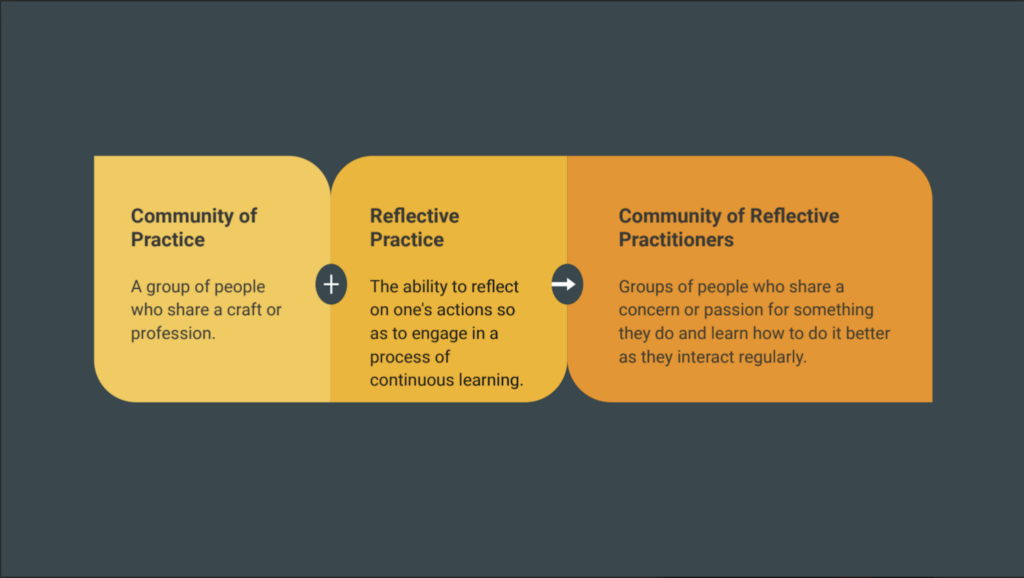
Teachers worked in mixed-division groups, with varying years of experience in the field. The morning opened with a grounding activity in which teachers were shown photographs of individuals who have affected positive change in the world. These individuals have raised awareness around difficult issues, often putting their lives and work at risk to do the “right” thing. Teachers were asked to work with their groups to list the qualities of one of those changemakers. Following a share-out, the group reflected on how we can encourage these qualities in all of our students. This impactful exercise grounded us in the knowledge that each child is under “self construction” and we have the big responsibility of allowing their true light to shine, while helping guide them in becoming their best self.
Following this exercise, Nancy and Jessica shared what resources and experiences they have to support teachers during the 2023-24 school year. As our instructional coach, a role dedicated to support faculty in their professional development, Nancy worked closely with Jessica to design a collaborative problem-solving approach for schoolwide implementation. The model offers teachers a practical tool for seeking input from one another and leveraging the cumulative knowledge of our faculty and staff.
This collaborative problem-solving model has teachers sharing a specific behavior they are experiencing with a child in their classroom. A group of educators, with one facilitator and one recorder, reflects on the overall question, “What’s going on with this child?” and what are the unmet needs, lagging skills, or obstacles that the student might be encountering? By looking at the heart of the issue, we honor the child and seek to better understand what their behavior is telling us. The facilitator then takes the group through a series of brainstorming questions, while the recorder writes strategies and suggestions. In the end, the teacher chooses a strategy to try out for a week and agrees to report back to the group. At that point, they may revisit the brainstorm and select another strategy to try.
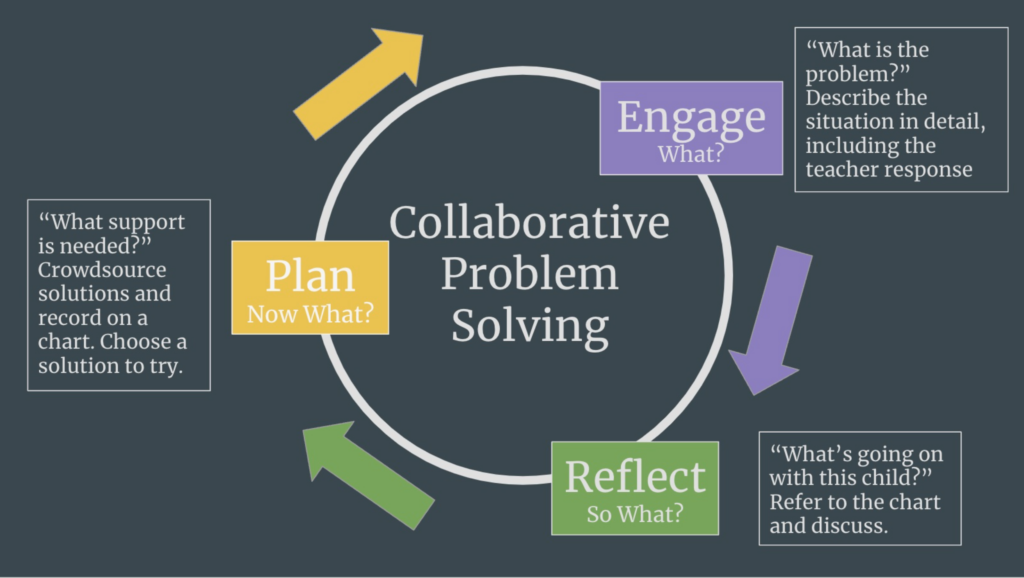
After modeling this process for everyone, teachers split into their mixed-division groups to practice the model. The value of this collaborative approach is vast, as it’s an opportunity for teachers to gain new perspectives and insight, helping create a shift in paradigm and introducing new ways of responding to student needs. It’s about connecting with colleagues and taking a child-centered approach, as much as it’s about reflecting on our own vulnerabilities and finding strength in the process. It is not about “fixing” a behavior, but opening ourselves to trying new approaches and embracing the spirit of the child.
During our October 6 teacher workday, our group of reflective practitioners reunited to share how our new system of collaborative problem solving is helping them in the classroom. Mixed-division groups reported out on strategy successes and areas of growth. More teachers had the opportunity to share a new challenge with their groups and seek strategies to try. Faculty feedback for this process has been overwhelmingly positive, and we are excited to be working closely together to authentically support students and to address their most critical needs.
Teachers spent the latter half of the workday looking at the scope and sequence of their Montessori curriculum, evaluating it with a fine-toothed comb to ensure fidelity and best-practice in every classroom. This “big work” is just one more way we are reflecting on our practice and ensuring that every student at GMS is engaged in meaningful work as they progress from Toddler through Junior High.
Through intentional planning, we make professional development at GMS relevant and meaningful. We consistently follow-up with faculty to ensure we are meeting their needs and supporting their professional growth. From workshops, trainings, and conferences to observations at other schools, professional development offers inspiration and connection for GMS teachers.
Dr. Maria Montessori was nominated for the Nobel Peace Prize in 1949, 1950, and again in 1951. Dr. Martin Luther King, Jr. was awarded the Nobel Peace Prize in 1964, becoming the youngest man to receive the honor at the time. They were both influenced in their work for peace by Mahatma Gandhi. In the 1930’s Maria Montessori met Mahatma Gandhi while she was living in India, and Gandhi gave a speech to Montessori teachers in training in London in 1931. There he said of her work, “You have very truly remarked that if we are to reach real peace in this world and if we are to carry on a real war against war, we shall have to begin with children.” While Dr. King did not meet Gandhi in person, he referred to him as “the guiding light of our technique of nonviolent social change.”
These three peacemakers have been great influencers across cultures. Dr. Montessori established educational training programs that have led to thousands of schools all around the world. Dr. Martin Luther King, Jr. organized peaceful protests that changed civil rights laws in the United States and inspired future peaceful protest around the world. They all changed the world through peaceful efforts.
At Greensboro Montessori School, we implement the peace curriculum at every age level - from guiding toddlers to self calm to teaching peaceful conflict resolution in our preschool and elementary classrooms, to visiting the United Nations in Junior High. We seek to provide experiences for children to understand and access the peace within themselves, to relate with other people, cultures, and the environment, and to embrace the complexity of humankind. When children are given opportunities to practice peace within themselves, they will be able to share it with others and seek it out in the world.
Dr. Martin Luther King, Jr. said, “The function of education is to teach one to think intensively and to think critically.” These peacemakers have influenced generations. And inspired by their work, Greensboro Montessori School is educating the next generation of peacemakers and innovators.
Greensboro Montessori School partners with the Northwest Evaluation Association (NWEA) to use Measure of Academic Progress (MAP) Growth assessments. MAP Growth is a computer-adaptive test for measuring individual student achievement and growth in math, reading, and language usage.
We've chosen MAP Growth because it is a student-centric approach to standardized testing. Unlike paper and pencil tests, where all students are asked the same questions and spend a fixed amount of time taking the test, MAP Growth is an adaptive test. That means every student gets a unique set of test questions based on responses to previous questions. At the end of each test, teachers are able to determine what individual students know and are ready to learn next.
Unlike traditional standardized tests, MAP Growth testing is administered twice a year, enabling us to measure our students' individual growth over time. Teachers may also use test results to further inform instruction, personalize learning, and monitor student growth.
While we are not a test-driven school, we know test taking is a practical life skill students need in preparation for high school and college. MAP Growth tests are one form of assessment we use, in conjunction with other methodologies of formative and summative assessment given throughout the school year.
About MAP Growth
No. As a computer-adaptive assessment, MAP Growth will provide questions to test the upper limits of your child's skills. Every student will miss questions. The MAP Growth guides suggest that students should expect to miss 40-60% of their questions.
There is no particular score for which students should aim. Instead, your child's individual MAP Growth Report will contain a RIT score. This score represents their achievement level at the time they took the test. As a partner in your child's education, we are less concerned one-time scores and will focus more attention on students' growth measures between assessments.
During MAP Growth
After MAP Growth
Preparing for MAP Growth Assessments
There is nothing families need "to do" in preparation for a MAP Growth test. We encourage families to follow the child – provide the level of support they need to feel successful. This could vary between treating an assessment day like any normal school day to practicing questions on a sample to get comfortable with the format, to talking with your child about the practical life skill of testing (i.e., tests are part of education and you should do your best, and you should not worry or stress over tests).
If you'd like to provide a strong framework for your child before and during a test, we have these tips:
The Night Before
- Relax and have fun.
- Enjoy a healthy snack an hour before bedtime.
- Get a good night's sleep.
The Morning of the Test
- Fill up on healthy, complex carbs and protein.
- Slow-release carbohydrates, like whole rolled porridge oats, whole grain bread, low-sugar muesli, and fresh fruit with a low glycemic index, help provide consistent energy levels throughout the morning.
- Proteins, such as milk, yogurt, or eggs, keep students feeling full and can lead to greater mental alertness.
- Prepare and bring a healthy midmorning snack to school.
- Arrive at school on time – no later than 8:15 a.m.
- Connect with a friend or teacher if you have pretest jitters.
During the Test
- Take three deep breaths.
- If you don't know the answer, give your best guess and move on.
As they do every spring, Greensboro Montessori School's Junior High students recently engaged in their final Great Debate of the year in history. Students addressed and argued both sides of two debates. The first questioned whether the purposes of government are best served by an authoritarian approach. The second questioned whether the primary role of a government should be to meet the needs of its people. The debates provide Junior High students the opportunity to argue in a logical and clearly defined manner.
 While The Great Debates are usually hosted in the classroom, this year's final debates were argued virtually through Google Hangouts. 57 participants, including students from both Junior High and Upper Elementary, attended the event, deepening their understanding of many forms of government and economic systems, including authoritarian, capitalist, communist, and socialist.
While The Great Debates are usually hosted in the classroom, this year's final debates were argued virtually through Google Hangouts. 57 participants, including students from both Junior High and Upper Elementary, attended the event, deepening their understanding of many forms of government and economic systems, including authoritarian, capitalist, communist, and socialist.
How the Debates Work
Teams of two or three students are given their topic in advance, but they do not learn which side they are on, for or against, until the morning of the debate. As a result, they must analyze and evaluate both sides and research and compile points and examples supporting both arguments. Each student writes two formal position papers, one for each side of the argument. This helps them broaden their thinking and mental flexibility.
 The debates follow a modified version of standard debate procedure, with an opening argument, sometimes shared by two teammates; time for preparation of rebuttal; and then closing arguments and rebuttal, by the remaining member of the team. Faculty members observe, discuss and provide extensive oral feedback to the teams about the debate.
The debates follow a modified version of standard debate procedure, with an opening argument, sometimes shared by two teammates; time for preparation of rebuttal; and then closing arguments and rebuttal, by the remaining member of the team. Faculty members observe, discuss and provide extensive oral feedback to the teams about the debate.
How Topics are Selected
The topics of the debates are drawn from subject matter the students have discussed in history classes during the preceding several weeks. Students are encouraged to go beyond the class discussions in gathering information and building their arguments.
The process allows students to go beyond what they have learned and apply it to larger questions, to develop their reasoning and ability to build and support logical arguments, and to gain confidence and develop greater precision in presenting their thoughts persuasively.
How We Learn
As Junior High students move into and through adolescence, it’s imperative they receive authentic support for their burgeoning philosophical questioning, curiosity in the world around them, and deep desire for belonging within their peer group. Greensboro Montessori School honors these needs through the concept of valorization, which is a pillar of our Junior High curriculum.
Valorization is the process of understanding you are a strong and worthy person. It is the process of self-actualization and fulfillment. It is not about surviving hours of arbitrary homework or memorizing facts for the next test. It’s about completing meaningful work, unleashing academic excellence, and solving real-world problems.
The Great Debates are just one example of how Greensboro Montessori School students experience valorization by developing self-worth, skills, and courage through purpose-filled work. Learn more about how we build valorization through our science curriculum in our recent blog about Trout in the (Indoor, Outdoor, and Virtual) Classroom.
If you are interested in learning more about Greensboro Montessori School's student-centered Upper School serving motivated learners in fourth to ninth grades, we encourage you to schedule a virtual information session. We welcome an opportunity to meet you, learn more about your family, and explore Greensboro Montessori School could partner with your family.
Greensboro Montessori School's Junior High students just culminated one of their project based learning assignments – hatching, growing, and releasing brown trout.
Junior High science teacher, Tim Goetz, released the trout in a cold water tributary of the Smith River near Bassett, Virginia. It was a Friday morning in the middle of the COVID-19 pandemic. Normally, our Junior High students would have been stream-side with Tim, and it would have been their job — not their teacher's — to complete the final step of their semester-long project. Instead, students joined Tim virtually to watch the trout meet their natural habitat.
As the trout grow, they will make their way up river into the Smith River. Along the way, they will eat land and water insects, zooplankton, worms and other aquatic creatures. They will also search for hiding places from predators, including birds and other fish. Tim Key, a member of the Nat Green Fly Fishers Club, who was present at the release said "these are some of the best fish I have every seen."
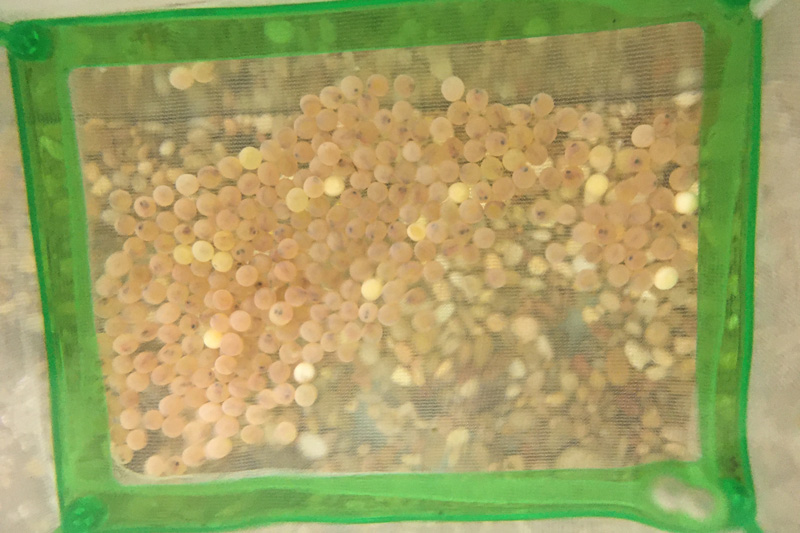 The fish were hatched at Greensboro Montessori School as a part of the nationwide Trout in the Classroom program, with support from the Dan River Basin Association, and Tim Key of the Nat Greene Fly Fishers Club. Over 250 eggs were given to the School on December 5, 2019 and the first hatch was December 10.
The fish were hatched at Greensboro Montessori School as a part of the nationwide Trout in the Classroom program, with support from the Dan River Basin Association, and Tim Key of the Nat Greene Fly Fishers Club. Over 250 eggs were given to the School on December 5, 2019 and the first hatch was December 10.
The fish were raised in a 45-gallon, cold-water aquarium at 50 degrees Fahrenheit in Greensboro Montessori's Upper School. To quickly prepare the correct growing environment, students mixed five gallons of water from the School's pond with 40 gallons of tap water. Students tended to the fish daily, including feeding, changing water, and water testing. Daily water tests included pH, ammonia, and nitrites with the goal of recreating a natural, cold-water trout habitat. This attention to detail resulted in the science room smelling more like an outdoor classroom next to a river than a traditional classroom.
Eighth grade student, Nina, was the head aquarium tender and her classmate, Ava, provided the backdrop art for the aquarium.
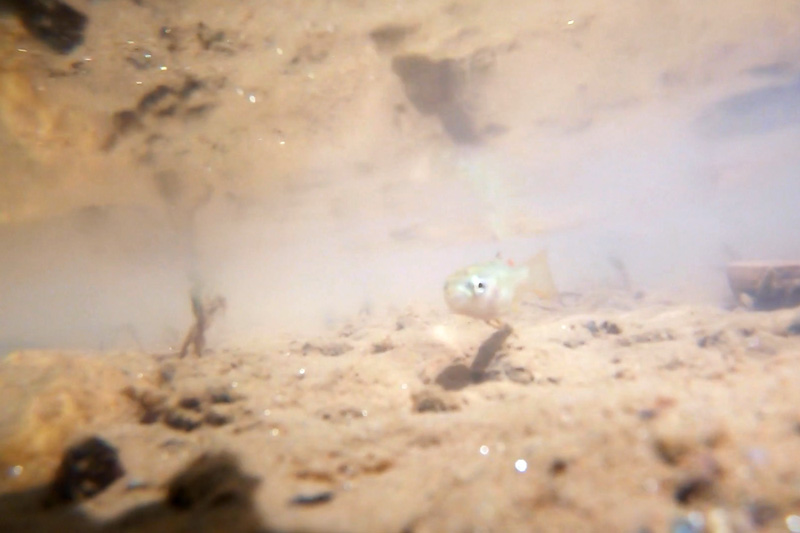 Prior to COVID-19, Junior High students were scheduled to travel to Virginia to release the trout themselves. Their expedition would have been part of their April Land Week, one of several weeks a year when they learn at Greensboro Montessori School's 37-acre satellite campus in Oak Ridge, N.C. With schools throughout the state suspending in-person learning, the students' land week and field trip was cancelled, but not their learning. Students participated in the trout release through a Live Lesson via Google Hangouts. Tim also documented the release on GoPro cameras so he could share the experience with the entire school community, Toddler through Junior High. After all, Greensboro Montessori School students learn everywhere, whether its the indoor, outdoor, or virtual classroom.
Prior to COVID-19, Junior High students were scheduled to travel to Virginia to release the trout themselves. Their expedition would have been part of their April Land Week, one of several weeks a year when they learn at Greensboro Montessori School's 37-acre satellite campus in Oak Ridge, N.C. With schools throughout the state suspending in-person learning, the students' land week and field trip was cancelled, but not their learning. Students participated in the trout release through a Live Lesson via Google Hangouts. Tim also documented the release on GoPro cameras so he could share the experience with the entire school community, Toddler through Junior High. After all, Greensboro Montessori School students learn everywhere, whether its the indoor, outdoor, or virtual classroom.
Learning through purpose-filled, project-based learning — like hatching, raising, and releasing brown trout into their natural habitat — is not the exception to the rule at Greensboro Montessori School. It is the rule. Our students learn through completing meaningful work, which often results in real-world benefits to the community. Through the multistep process of researching, designing, implementing, refining, analyzing, and presenting their projects, our students gain real-world skills such as resiliency, creativity, curiosity, time management, and public speaking. They also develop a sense of self-worth by understanding the value of their contributions to society and experiencing personal fulfillment.
Click here to read about about another real-world project our Junior High students are leading: inoculating, growing, harvesting, and selling shiitake mushrooms.
In addition to Trout in the Classroom, Dan River Basin Association, and Nat Greene Fly Fishers Club, Greensboro Montessori School would like to thank Oliver Rouch from K2 Productions for lending us GoPro cameras and editing our release footage. We also want to thank Tim Key for his work behind the camera.
After a long day away from our children, we parents are eager to hear all the details about how they have spent their time. However, so often our queries of “What did you do today?” are met with the same predictable response: “Nothing.” For children, distilling the many details and experiences of a full day at school into an anecdote or two is a tall order. What tools can we use to get them talking about their learning?
Vidigami
Through the Vidigami private photo sharing platform, you get to see moments of your child’s day at school. Viewing photos of your child engaged with Montessori materials can inspire great conversations. Children, especially those younger than five, are not yet able to summarize and describe the many things they experience over the course of a full and stimulating school day. However, photos offer visual cues that trigger a child’s memories and invite them to comment on specific materials and activities. There are many different ways to talk about these photos with your child, and we've provided some suggestions, which focus on your child's intrinsic motivation. Enjoy these special conversations as you allow them to teach you what they are learning at school.
- Ask your child to tell you about the photo. You may learn what they see in the classroom, or what they remember about the moment, and it may be much more than meets the eye.
- Say what you see without judgement. “I notice you are in the classroom.” “Do you know the name of that work?” “There are a lot of colors in your drawing.”
- Speak about their efforts instead of praising their product. “You really look like you are concentrating.” “Is that the first time you have done that work?” “I see your smile. What did you like about that work?” “Are you building with those blocks?”
Intrinsic Motivation
Listening to your child talk about the photos and speaking without judgement encourages your child's intrinsic motivation – it allows them to continue to work for their own sake, rather than for any praise from adults. As Montessori teachers, we get to witness this intrinsic motivation every day. It looks different at each age grouping and is a critical element to Montessori education. Many elements of the method foster intrinsic motivation without reward and judgement, such as control of error in the materials, allowing for repetition, assessment through observation, and relying on peers as sources of feedback and inspiration. Teachers try never to interrupt a concentrating child or judge their work. Instead, they seek opportunities for meaningful conversations before or after a student's work cycle.
As Montessori observed children, she saw time and time again the intrinsic motivation in the child to work through repetition for long, uninterrupted periods of time. In a book that examines Montessori’s relevance to today’s educational practices, "The Science Behind the Genius," Angeline Lillard refers to several current research studies confirming that rewards and punishments not only negatively impact intrinsic motivation, but also how a student performs on the task. Traditional reward methods used in most schools may actually hinder a child’s performance. Given the opportunity, children are capable of learning to take personal responsibility for their actions.
“Like others I had believed that it was necessary to encourage a child by means of some exterior reward that would flatter his baser sentiments … in order to foster in him a spirit of work and of peace. And I was astonished when I learned that a child who is permitted to educate himself really gives up these lower instincts.” – Dr. Maria Montessori
As a Montessori school, we believe deeply in educating the whole child: their academic, psychological, critical-thinking, moral, and social-emotional selves. In addition to the academic lessons and works your children are engaged in daily, our teachers and staff are also guiding your child through other very important lessons to help them with their moral and social-emotional development. For example, teachers give explicit lessons related to grace and courtesy, facilitate discussions at the peace table, and encourage collaborative work and play daily.
And, it turns out, research from our School confirms that we are doing this pretty well …
The Gratitude Project
We recently worked with Professor Jonathan Tudge and his team from the University of North Carolina at Greensboro ("UNCG") to study the development of gratitude as a virtue. As a virtue, gratitude goes beyond a positive feeling when something good happens. Virtuous gratitude is a disposition to act gratefully when someone else does something nice for you. Dr. Tudge explained it to me this way: “Saying 'thank you' is polite, but hardly a virtue. What makes gratitude a virtue is when beneficiaries of good deeds or significant help want to do something back for their benefactor if they have the chance to do so. That first act of generosity, followed by grateful reciprocity, leads to building or strengthening connections among people.”
In previous cross-cultural research, Dr. Tudge and his team found that most children develop this type of gratitude between the ages of 9 and 13, although the age differed depending on the cultural context. In their study, children in the United States developed virtuous gratitude at later ages than other cultures. Keeping this in mind, Dr. Tudge decided to target a new intervention designed to encourage the development of gratitude within adolescents.
Dr. Tudge and his team came to our School to explore this intervention. After working with our Upper School students, they stumbled upon a ‘good’ problem with their research: far more Greensboro Montessori School students exhibited virtuous gratitude than they expected. Our Upper Elementary and Junior High students expressed gratitude at much higher rates (67%) than did children in non-Montessori settings in the United States (46%). In addition, our students were almost twice as likely to express autonomous moral obligation (79%) than were children in non-Montessori schools (44%). Defined originally by Jean Piaget, autonomous moral obligation is a decision-making framework whereby moral decisions are made based on intrinsic motivations to do the right thing.
Dr. Tudge and his team were puzzled by these anomalous findings. Why did our students score higher than other American children, even when compared to other well-regarded private schools in the Greensboro area? And how are these findings related to Montessori pedagogy and culture?
Gratitude in the Montessori Classroom
In our discussions with Dr. Tudge, we discussed the way Montessori teachers prepare the environment to communicate honor, respect, and gratitude to the child. We also described the ways in which our teachers model gratitude and respect when they speak and interact with their students. In time, this becomes our students' definition of "how it's supposed to be.” In addition, we delineated how our grace and courtesy curriculum creates both a framework for community interactions and a schoolwide culture of character.
In collaboration with Dr. Tudge and his team, I presented the results from our Upper School students’ involvement with Dr. Tudge's gratitude study at the Association for Moral Education’s annual conference in Seattle, Washington.
In the presentation, we hypothesized that our students' high rates of gratitude could be due to several specific tenets of Montessori philosophy:
- Specific lessons about grace and courtesy provide explicit guidance on character development from a young age.
- Daily practice of grace and courtesy increase opportunities for proximal processes related to virtue development.
- Mixed age groupings of children may expose younger children to older children are further along in virtue development.
- Peer interactions encouraged from toddlerhood may increase opportunities for the development of mutual respect.
Dr. Tudge and his team also did some work with our Lower Elementary students. Tudge’s team again noted that so many of even these younger children (aged 6 to 9) expressed virtuous gratitude. Dr. Tudge reflected: “We think that this must say something about the character-based focus of the general Montessori curriculum, because a far greater proportion of Greensboro Montessori School children expressed gratitude than elsewhere.”
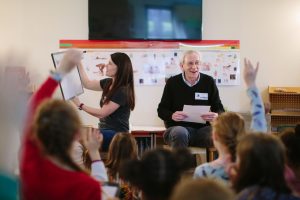
Dr. Jonathan Tudge and his team from UNCG discuss gratitude with Lower Elementary students from Greensboro Montessori School Students.
Character Education at Greensboro Montessori School
Overall, the results suggest that a Montessori environment is conducive to developing virtuous gratitude and autonomous moral obligation. These results – while surprising and interesting to the UNCG team and other researchers and educators at the Association for Moral Education conference – are not really that surprising to us. Focusing on strong character education is a key tenet of Greensboro Montessori School. A deep respect towards classmates and other people is so integral to our culture that it's not that surprising our Elementary and Junior High students authentically take their sense of gratitude to a level beyond just saying “thank you.”
Greensboro Montessori School's Junior High student council members usually plan three dance parties a year, one each in the fall, winter, and spring. Whether an upcoming dance is your child's first or they have attended these kinds of functions before, we have some details to help you plan ahead.
When: Greensboro Montessori School dances are on a Friday night from 7 to 9:30 p.m.
Where: Dances are hosted in Greensboro Montessori School's Gymnasium
Who: Attendance is limited to currently enrolled students in grades six through nine. In general, students may not bring guests from other schools. In some instances, Greensboro Montessori School has invited other independent schools in the Independent School League to attend dances, but this is the exception to the rule.
Attire: Students may choose to dress up or wear regular clothing. Attire must follow Greensboro Montessori School's dress code. We ask all attendees to wear soft-soled shoes that will not scuff or leave marks on the gym floor.
Chaperones: All dances are chaperoned by faculty and staff from Greensboro Montessori School. On the night of the dance, parents may drop-off their child at the Gymnasium entrance at 7 p.m. and return at 9:30 p.m. when the dance is over. The School always provides the name and cell phone number of at least one chaperone in a personal email to parents.
Cell phones: Students are permitted to bring cell phones to dances.
Entrance Fee: Students pay $5 cash at the door to attend dances.
Music: All Greensboro Montessori School dances have a DJ who is a current student. They develop a playlist based on student requests and submit this playlist for review by their faculty advisor. The faculty advisor reviews the list for content and language and approves only those songs which are age appropriate.
Dr. Maria Montessori was a big fan of field trips. In her words, it was important for students to take “outings” or to “go out.” In 1948, Dr. Montessori wrote: “The outing whose aim is neither purely that of personal hygiene nor that of a practical order, but which makes an experience live, will make the child conscious of realities … When the child goes out, it is the world itself that offers itself to him. Let us take the child out to show him real things instead of making objects which represent ideas and closing them up in cupboards.” Hence, the Montessori phrase of “going out” was born.
At Greensboro Montessori School, we take the Montessori tradition of “going out” to heart, as our students take academically aligned, overnight field trips beginning in Lower Elementary. Where lessons in the classroom are a springboard to learning, Montessori outings provide the experiences necessary to move concepts from the abstract to the concrete – to let students apply and expand their knowledge in the world around them.
As our students progress from Toddler to Junior High, they learn the rites of passage, including the field trips, which will greet them along the way. Read about all our adventures, or jump to the grade which interests you most!
Lower Elementary
Second Grade: Students enjoy their first overnight outing in second grade. This year, our second graders will spend a night at The Land, our 37-acre satellite campus in Oak Ridge. This wooded retreat includes a 14-bedroom retreat center, a barn, a covered bridge spanning a freshwater stream, mature hardwoods, peaceful trails, privacy and seclusion, and diverse flora and fauna.
Third Grade: Third graders take annual trips to either Earthshine Discovery Center in the Nantahala National Forest in western North Carolina or the Sound to Sea program along the North Carolina’s Crystal Coast. Students spend two days and three nights building upon their lessons in biology, botany, environmental studies, geography, and physical science.
Upper Elementary
Fourth and Fifth Grade: Fourth and fifth graders rotate between annual field trips to North Carolina’s Outer Banks and Colonial Williamsburg every spring. When at the North Carolina coast, our students experience the region’s rich marine biology and storied history. Students visit national landmarks like Roanoke Island, the first settlement of English colonists, and the Wright Brothers National Memorial in Kitty Hawk. In the words of the National Parks Service, Kitty Hawk is the site where Wilbur and Orville Wright “experimented with flight in the early 1900s, and finally succeed[ed] on a cold winter day with the world's first controlled, sustained, powered, heavier-than-air flight.”
When visiting Williamsburg, students immerse themselves in the history of the American Revolution and explore, as Colonial Williamsburg puts it, “the political, cultural, and educational center of what was then the largest, most populous, and most influential of the American colonies. It was here that the fundamental concepts of our republic — responsible leadership, a sense of public service, self-government, and individual liberty — were nurtured under the leadership of patriots such as George Washington, Thomas Jefferson, George Mason, and Peyton Randolph.”
Sixth Grade: Sixth-grade students head to our nation’s capital, where they visit multiple Smithsonian museums, (including the National Museum of African American History and Culture and the National Air and Space Museum), the National Archives, Arlington National Cemetery, and the National Gallery of Art and Sculpture Garden. Students expand upon their knowledge of national government and civics, while practicing grace and courtesy in a metropolitan city center. Dr. Montessori writes: “A child enclosed within limits however vast remains incapable of realizing his full value and will not succeed in adapting himself to the outer world. For him to progress rapidly, his practical and social lives must be intimately blended with his cultural environment.”
Junior High
Seventh Grade: Greensboro Montessori School’s seventh graders head west to Tuscon, Arizona, where their years of environmental science studies take center stage in this week-long trip. In addition to hiking Kitt Peak, students spend time at the University of Arizona’s Biosphere 2, a state-of-the-art scientific facility. The mission of Biosphere 2 “is to serve as a center for research, outreach, teaching and life-long learning about Earth, its living systems, and its place in the universe; to catalyze interdisciplinary thinking and understanding about Earth and its future; to be an adaptive tool for Earth education and outreach to industry, government, and the public; and to distill issues related to Earth systems planning and management for use by policymakers, students and the public.”
Eighth Grade: Greensboro Montessori School’s eighth graders enjoy an authentic immersion experience in Costa Rica. Our students stay with the Costa Rican families of students from The Summit School, our sister school in Coronado, Costa Rica which is very close to the capital city of San José. Together, our students and the Ticos (a colloquial term for natives of Costa Rica) go everywhere together. They visit volcanoes, complete high ropes courses, and sail through the rainforest canopy on zip lines. They travel to the Caribbean Coast where they walk the beach at night looking for turtle eggs to bury in a nearby protected hatchery. Then, they travel to the Pacific side to snorkel and explore rain forests and animal sanctuaries. They also spend a day in downtown San José learning about Costa Rican history, art, and government. With every visit to Costa Rica, our students return with their eyes a little wider and their lives a little richer as they have their first experience actually living in another culture.
Ninth Grade: An important element of our ninth-grade curriculum is the completion of a year-long capstone project that challenges each student to apply their skills to an area of personal interest that will improve and enhance their world. Similar to a thesis or senior project, the capstone project provides a framework for demonstrating leadership and advanced application of critical thinking skills. To further extend their learning, the students are challenged to design a custom end-of-year outing to include research opportunities for each of their individual capstone projects. In collaboration with a faculty advisor, a past ninth grade class settled on an itinerary traveling throughout the Pacific Northwest. Their route took them to explore tidal pools, tour museums in Seattle, visit a military base in Tacoma, and interview refugees in Vancouver.


